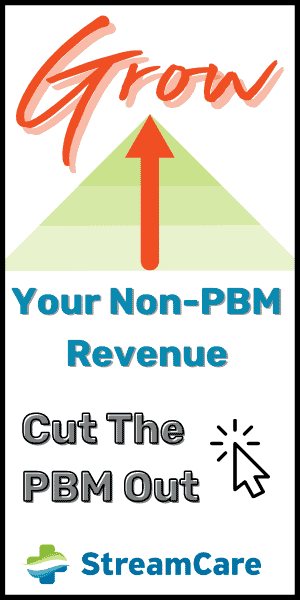Tax Savings for Pharmacy Owners: What You Need to Know
Taxes might not be the most exciting topic, but they’re crucial to your financial health as a pharmacy owner. Knowing how to navigate deductions, credits, and tax planning strategies can make a big difference in your bottom line. Every dollar saved on taxes is a dollar you can reinvest in your business or take home. Tax savings is a critical strategy for having a business that serves you.
Many people don’t like to pay taxes, so they avoid the subject. As a pharmacy owner, you cannot afford to do this. While you don’t need to become a tax expert, I recommend becoming tax knowledgeable so that you can become an active partner in saving on your taxes.
So, let’s explore some actionable ways to optimize your tax situation as a pharmacy owner.
1. Take the Section 179 Deduction for More Tax Savings
If you’ve invested in new equipment or technology for your pharmacy this year, you could qualify for a Section 179 deduction. This allows you to deduct the full cost of eligible equipment in the year it’s purchased rather than depreciating it over time.
Examples of Eligible Purchases:
- Pharmacy automation systems
- Computer hardware and software
- Shelving and display units
- Compounding equipment
Key Details:
- The annual deduction limit for 2024 is $1,220,000.
Before you make any large purchases, it is a great idea to check with your accountant to ensure you qualify and double check the timing of your purchase is best for you.
2. Maximize Deductions for Employee Expenses
As a pharmacy owner, you likely spend a significant amount on staffing. Many of these expenses are tax-deductible.
Deductible Employee Costs:
- Salaries and wages
- Health insurance premiums
- Retirement plan contributions
- Training and professional development expenses (like going to the Pharmacy Profit Summit!)
- Employee recognition and appreciation events
Consider setting up a 401(k) plan for your employees. Not only is it a great benefit, but your contributions as an employer are tax-deductible. Also, ensure any bonuses you give employees are tracked through your books so you can deduct those expenses.
3. Don’t Overlook Small Business Tax Credits for Tax Savings
Tax credits directly reduce the amount of tax you owe, making them more valuable than deductions. Here are a few to consider:
Small Business Health Care Tax Credit:
- If you provide health insurance for your employees, you could qualify for a credit of up to 50% of premiums paid.
Work Opportunity Tax Credit (WOTC):
- This credit rewards you for hiring employees from certain target groups, such as veterans or long-term unemployed individuals.
Pro Tip: Work with your accountant to identify and claim every credit available to you.
4. Deduct Your Home Office (If Applicable)
If you use a portion of your home exclusively for business purposes, you may be able to deduct home office expenses. This is especially relevant if you handle administrative tasks, inventory management, or telehealth services from home.
What You Can Deduct:
- A portion of your rent or mortgage
- Utilities and internet costs
- Office furniture and supplies
It doesn’t have to be complicated. Use the simplified deduction method, which allows you to deduct $5 per square foot, up to 300 square feet, if calculating actual expenses feels too cumbersome.
5. Leverage Depreciation for Your Building
If you own the building where your pharmacy operates, you can benefit from depreciation deductions. This allows you to recover the cost of the building over its useful life.
Key Details:
- Commercial properties are typically depreciated over 39 years.
- Recent improvements, like HVAC systems or new lighting, may qualify for accelerated depreciation.
If you own your building, I highly advise you to get a cost segregation study done to identify components that can be depreciated faster, such as fixtures or specific building systems.
6. Track and Deduct Vehicle Expenses
If you use a vehicle for business purposes, whether it’s for deliveries, attending industry events, or running errands, you can deduct related expenses.
How to Deduct:
- Use the standard mileage rate (67 cents per mile for 2024).
- Alternatively, deduct actual expenses, including gas, maintenance, and insurance.
You can keep an old-school detailed paper log of your business-related mileage to substantiate your deduction. Or there are now apps that can make it easier, like MileIQ.
7. Invest in Retirement Plans to Increase Tax Savings
Saving for your future doesn’t just benefit you—it’s also a smart tax strategy. Contributions to retirement plans are tax-deductible and help reduce your taxable income.
Options to Consider:
- SEP-IRA: Ideal for sole proprietors or small businesses.
- Solo 401(k): Perfect for owner-operators with no employees.
- Traditional IRA: Available even if you’re contributing to another plan, though income limits may apply.
For many retirement plans, you can have until the tax filing deadline to fund the account for the previous year. Max out contributions to lower your taxable income significantly. Discuss with your tax professional how to best set up all your business entities to be able to max out retirement for you or your spouse.
8. Employ Your Children
If your children do work for you, treat them like an employee so you can deduct their payroll expenses, and they can contribute to their own retirement accounts with their earned income. Your business profit will be reduced, and, in many instances, your children won’t have to pay any taxes as they will be below the limit to be taxed.
You don’t have to use a payroll company for your children, though I think that is easiest. If you don’t use a payroll company, you need to keep good records.
9. Plan for Quarterly Tax Payments
As a pharmacy owner, you’re likely required to make estimated tax payments each quarter. Missing these payments can result in penalties, so it’s essential to plan ahead.
How to Calculate:
- Estimate your annual income and tax liability.
- Divide this amount into four payments, due in April, June, September, and January.
Work with your tax professional so you can get accurate estimates. It is also a good idea to have a separate account that you can use to set aside a percentage of your monthly income to cover your quarterly payments.
10. Work with a Tax Professional
Knowledge is power. Tax laws are complex and constantly changing. A skilled accountant or tax advisor can help you identify additional savings and ensure compliance.
What to Look For in a Tax Professional:
- Experience with entrepreneurs is a must and bonus points for pharmacies.
- Deep knowledge of business owner deductions and credits.
- Proactive communication about tax-saving opportunities.
Schedule a mid-year review (at a minimum) with your tax professional to adjust strategies as needed. Extra credit is earned if you do it every quarter.
Final Thoughts
Taxes don’t have to be a source of stress. With the right strategies and professional guidance, you can minimize your tax burden and keep more of your hard-earned money. By planning ahead, staying organized, and taking advantage of every deduction and credit available, you’ll set your pharmacy up for financial success. For more tax savings, check out my earlier blog HERE.
And Pharmacy Badass University members, be sure to check out all of the tax savings content in the membership. We have trainings and videos from tax master Tom Wheelwright, along with helpful tips shared by other members.
The time to plan tax savings is before April 15 is here!


















